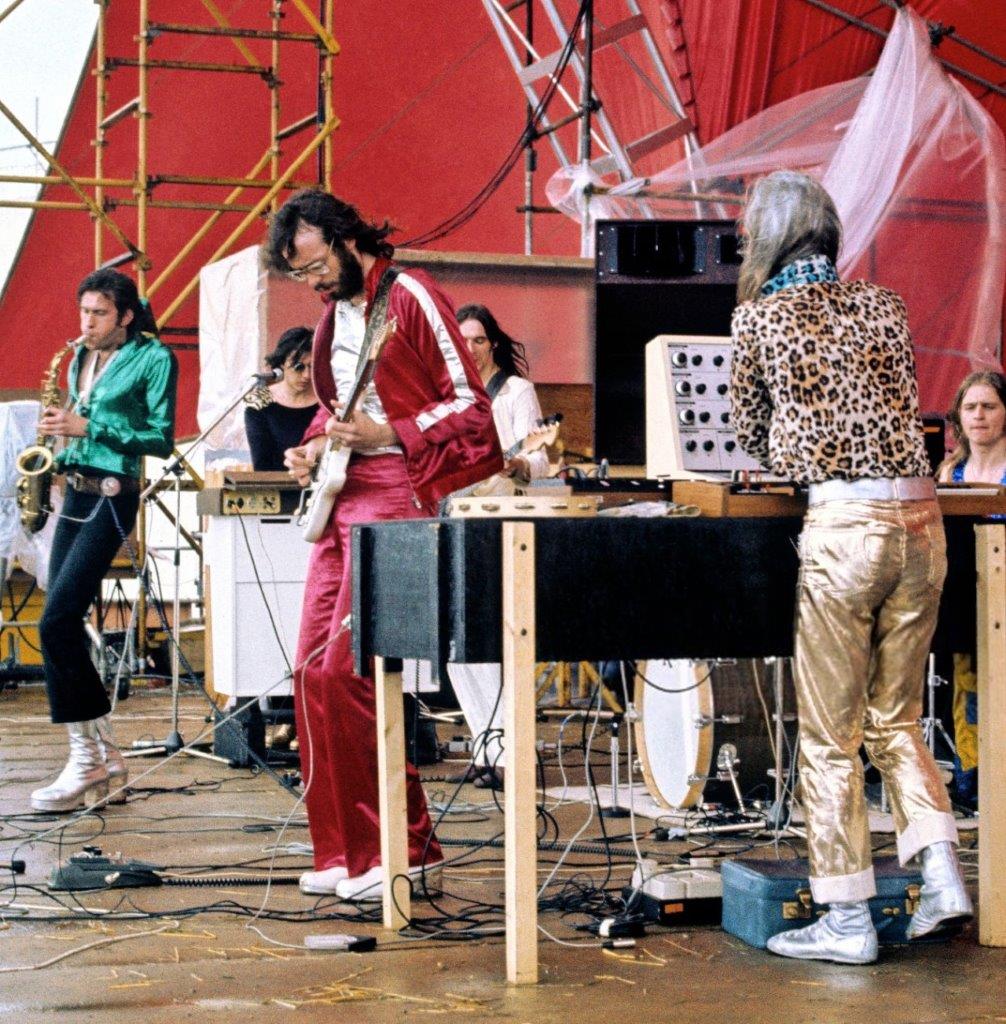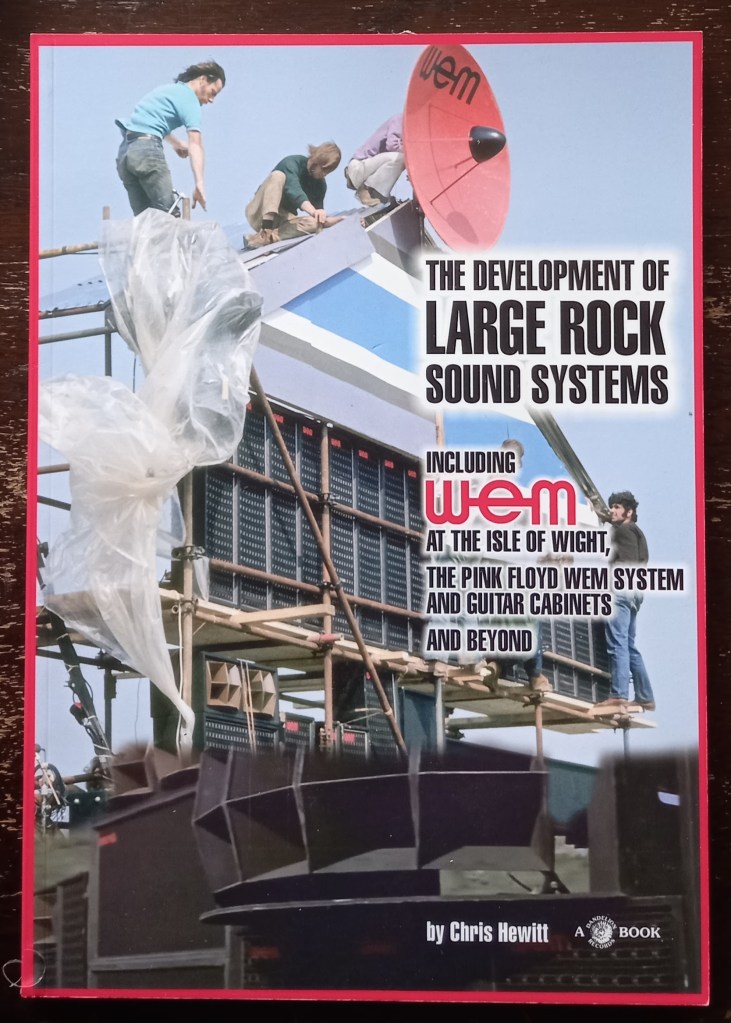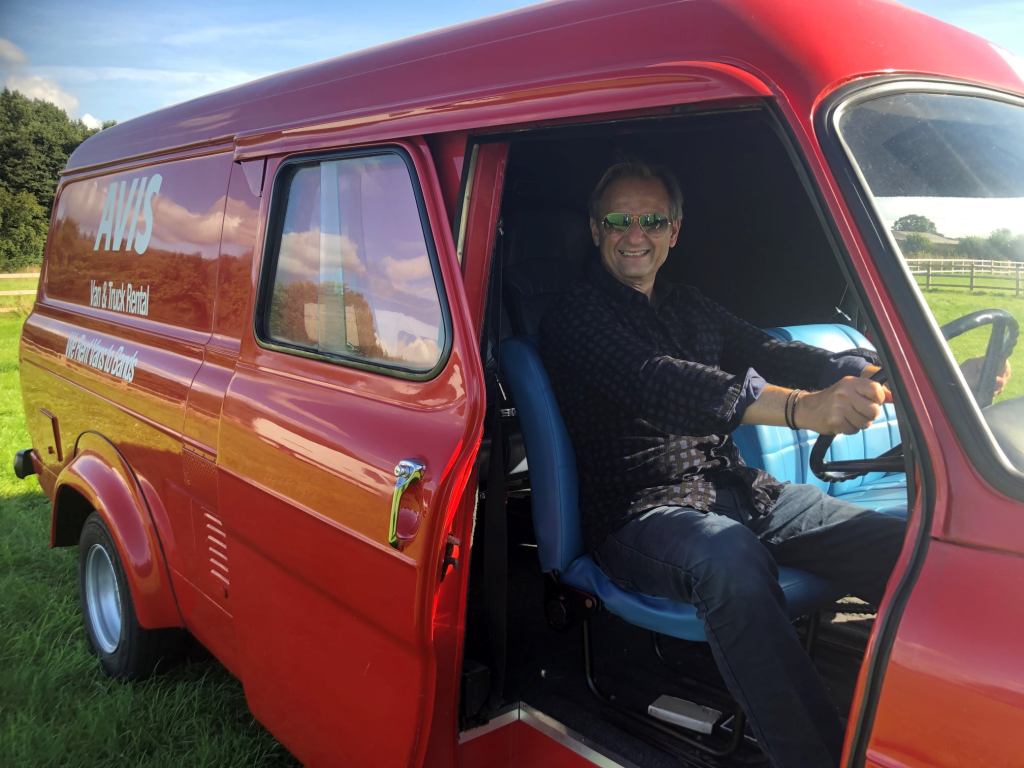
In the last three years alone, Chris Hewitt has published four mighty tomes neatly summing up his rather niche love of, and involvement with, live sound systems and outdoor music events down the decades.
Regular readers may already know the back story of this veteran promoter and vintage PA sound system archivist and collector, described on air at BBC 6 Music as a ‘musical archaeologist’, Chris by day running CH Vintage Audio, hiring out 1960s and 1970s sound equipment, having amassed an impressive collection over the years.
His CV includes involvement in recreating authentic sets for Danny Boyle’s TV miniseries Pistol, based on Sex Pistols guitarist Steve Jones’ memoir; work on Elton John biopic, Rocketman; Freddie Mercury biopic, Bohemian Rhapsody; Morrissey drama England is Mine; and Steve Coogan-fronted Jimmy Savile drama, The Reckoning.
Chris’ team also rebuilt 10cc’s legendary Stockport studio Strawberry Studios in its original building, recreating its control room, and recreated Pink Floyd’s legendary Pompeii set back home in rural Cheshire. And when he has a few moments to himself, away from the day-job, it turns out that he’s writing on related subjects too.
A year ago, we chatted about a 50th anniversary edition of his rather splendid book on 1972’s Bickershaw Festival (linked here), when a Wigan pit village was given over to major acts such as Captain Beefheart, Dr John, The Grateful Dead, The Kinks, Donovan, Hawkwind, and Al Stewart, one wet weekend in Lancashire.
Chris was a music promoter at Rochdale College back then, but his involvement helping promote Jeremy Beadle’s ground-breaking event ultimately inspired his own future direction in the industry.
And now we have the third part of his book series celebrating the development of rock sound systems. But before you can say ‘trilogy’, I should add that it’s highly likely there will be at least a fourth volume. He’s said so himself.

“When I first wrote, collated and published Volume 1 in 2020 it was to try and record the history of the PA industry and the companies that grew up as the demand for larger sound systems for larger festivals and larger indoor gigs increased.
“Volume 2 was released to celebrate 50 years since the Pink Floyd at Pompeii film, which must have inspired many musicians and sound engineers to want to build a large sound system. By then I was researching chapters on particular companies in the pro audio industry and on particular vintage PA systems like the Led Zeppelin and the Pink Floyd Pompeii WEM systems.
“Working on the Pistols’ Disney TV series recreations of classic Sex Pistols gigs in 2021 with various PAs brought me into researching Bowie/Ziggy and Ground Control at the Hammersmith Odeon in 1973, as that system had to be recreated for the film, so that led to the Bowie/Ground Control/Turner chapters.
“When PA systems first started being toured as hire systems and used for festivals, it was an industry of mavericks, often described by people who were doing it as pirates setting sail on a ship and not really knowing where they were going.
“Hire companies and manufacturers came and went or got taken over, bought out and reinvented. Sometimes the hire companies were set up by bands wanting to get their equipment used when not on the road, like Colac Hire (Colosseum) and Britannia Row (Pink Floyd).
“It usually started with someone building some bass bins and horns in their garage or building a mixer in their garden shed, and developed from there.”
When I initially spoke to Northwich-based Chris for this website in 2018 (with that feature/interview linked here), we focused on his triple-DVD/ hardback book combo marking Deeply Vale’s 40th anniversary reunion and links with legendary broadcaster John Peel, all his publications carrying the Dandelion Records brand, commemorating the underground label they were both involved with.

And talking of friends of Peel, broadcaster Mark Radcliffe recently described the latest volume of Chris’ impressive (and fittingly rather large) series of books as ’a further meticulously catalogued account of one man’s obsession with the architecturally huge audio systems that soundtracked some of the most historic rock ‘n’ roll gigs ever staged. And this time, there’s plenty of fascinating Bowie information to delve into for the uber-fan like myself.’
That’s true enough, with plenty to get the teeth into for fans of the likes of Led Zeppelin, Pink Floyd, Thin Lizzy, and 10cc too. And as Mark concludes, ‘Not everybody needs to know all this stuff, but for those who are interested, Chris knows more than anyone else I can think of.’ I’m thinking the author will take that as a badge of honour too.
Volume 1 started out by covering in depth the story of Watkins Electric Music, best known as WEM, its origins in founder Charlie Watkins mounting what he recalls was a ‘disastrous publicity tour’ with US legends The Byrds in 1966. Struggling to get his PA system louder than the new and very loud instrument amplifiers they were using, led him to join forces with a Belgian engineer and a French entrepreneur to attempt to build a hugely powerful PA using transformer-less transistor amplifiers.
And for the same reason that I have very little idea of how my TV, kettle and other appliances work around, I’ll step back from any in-depth description there. Besides, Chris tells you all you need to know (and more) through his retelling of that story and many others, with the help of interviews with key personnel involved and his own considerable insider knowledge.
In short, revolutionary new PA systems were introduced by the time I was born in 1967, transforming a scene that WEM suggested in their company publicity was until then ‘hampered with the old PA problems of feedback, lack of presence, distortion and downright unreliability.’
As it turned out, that particular firm never looked back, early field tests at the National Jazz Festivals, The Royal Albert Hall, and up and down the country in small clubs, churches, ice rinks, hotels, small venues and mammoth halls, and ‘once even in a zoo’, leading to so much more.
Soon enough, WEM’s clientele included The Who, Soho’s famed Ronnie Scott’s jazz club, Marc Bolan’s Tyrannosaurus Rex, Small Faces, The Nice, King Crimson, Jethro Tull, The Move, The Crazy World of Arthur Brown, and the afore-mentioned Pink Floyd. Meanwhile, its systems were used at those iconic Hyde Park open-air shows for Blind Faith, Donovan, Fleetwood Mac and the Rolling Stones.

There’s plenty about all of that, but it’s the human interest stories that Chris has researched and collated and the interviews he’s set up that grab me, and you can take for example Charlie Watkins’ revelation (at least to me) that David Bowie wrote much of ‘Space Oddity’ in his office.
Charlie is quoted as saying, “David was always nice and respectful to me, never offered me a joint or anything, appreciated what I was trying to do with live sound in that period, which was absolutely bloody primitive. I didn’t mind him eating his fish and chips off my desk, but I did have to tell him to take his bloody feet off my desk!”
Chris soon brings Charlie’s Balham near-neighbour John Thompson and Fleetwood Mac soundman ‘Dinky’ Dawson into the story, the company’s factory soon receiving regular visits from big name acts, WEM going on to play a major part in the 1969/70 Isle of Wight Festivals, and Chris intriguingly letting on that Fleetwood Mac and the Rolling Stones wanted ‘large sexual objects incorporated into their stage designs, inspired by Charlie’s large parabolic dishes.’
Meanwhile, we learn – with pictorial evidence – that legendary Who drummer Keith Moon soon had WEM garden speakers at his bungalow, the company’s work also involving major Led Zeppelin shows. As for Pink Floyd, the technical tale of their 1971 outdoor show at Pompeii is told in great detail, road manager Peter Watts recalling, “The sound had a sort of echo to it, not a dry sound like in a studio. The Romans who built the amphitheatre thought not only about the structure but also of the acoustic qualities.”
The limited-edition 500-copy first volume alone carried nearly 200 rare photos alongside Chris’ words and interviews, including some great shots of Jimi Hendrix on stage at the Isle of Wight Festival, while he also told of Floyd’s transition to Martin Audio from their WEM days.
Then, Volume 2 covered not just the development of the sound system in the ‘70s, but also the increasing quality and size of vans used from the ‘60s through to the ‘80s, and detailed not only Pink Floyd’s WEM gear at Pompeii in 1971 – including interviews with filmmaker Adrian Maben – but also that reconstruction of Floyd’s complete sound system from Pompeii in Cheshire 50 years later.
And as well as detail on Led Zeppelin’s WEM system, his chapter on the evolution of the band van includes some rather evocative photos of The Beatles’ Commer and the Rolling Stones’ Bedford CA vans, The Who’s and Status Quo’s Ford Thames vans, and the Ford Transit Mk.1s used by Black Sabbath, Brian Poole and the Tremeloes, Brinsley Schwartz, Camel, and Small Faces, the former snapped outside Tony Iommi’s terraced house in one of my favourite shots.

Chris also looks at companies in the ‘70s that hired equipment, some of the biggest equipment manufacturers, and his own personal journey into large PAs and festivals, with plenty about the sound systems used at the Deeply Vale Festivals and at Manchester’s Alexandra Park for the August ’81 CND event (including photos of The Damned and John Cooper Clarke), among others.
As for Volume 3, we get insight from the likes of Robin Mayhew on David Bowie’s highly influential Ziggy Stardust shows, details of Pink Floyd’s sound system from their Dark Side of the Moon era in ’73 through to 1977, and details of his company’s involvement with the Australian Pink Floyd tribute act in more recent times, a request to show the band’s UK-based Stephen McElroy his collection of WEM and Pink Floyd gear leading to Steve buying various vintage cabinets and Chris’ firm recreating the Pompeii sound system for the 50th anniversary in 2021 with Steve’s friends, including members of the band.
Then there’s a look at the California Jam (’54,000 watts of audio power… 105db spl at one mile… 200,000 satisfied rock fans’), a 12-hour event headlined by Emerson, Lake and Palmer in Ontario Motor Speedway, 40 miles east of Los Angeles), and more on the Great Western Festival in Bardney, Lincolnshire in May ’72, including some wonderful shots of the likes of Atomic Rooster, Genesis, Humble Pie, Roxy Music, Status Quo, Vinegar Joe, and Wishbone Ash.
Chris also profiles sound system companies such as Midas Mixers, Colac (Colosseum Acoustics), Wigwam, and MEH Tasco (The American Sound Company), the latter’s clientele including everyone from Bad Company and Black Sabbath to Frank Sinatra, including The Jackson Five at Wembley’s Empire Pool in ’72, Elton John at Watford FC’s Vicarage Road base in ’74, and The Who for their 1976 outdoor show at Charlton Athletic FC’s The Valley. And then there are tales from the ‘70s from Thin Lizzy’s roadcrew, and detail of 10cc’s sound systems and Strawberry Studios from that era.
As to those Lizzy live stories, by way of example there’s mention of a hair-raising episode involving road crew member Charlie McPherson, of whom we learn, ‘Charlie is from the Highlands of Scotland, and a good few years on the road has hardened his slim frame to the extent that he feels confident to deal with most minor disturbances.’ We then hear from Charlie how, “I remember a time in Devizes. There was this Hell’s Angel who had been drinking heavily. He lurched towards the stage and managed to lift the whole front part up with the boys still playing on top of it. In the end though, he just collapsed through the booze. In general, there’s very little trouble to deal with.”’
And then elsewhere we have Robin Mayhew, who worked on the Ziggy Stardust shows from March ’72 (‘to 200 people tops at Bristol University’) through to Hammersmith Odeon, before going on to work with Lou Reed, The Clash, The Stranglers, Blondie, David Essex, and Mott the Hoople, recalling, “All the Ziggy shows were fantastic. I remember one night David jumped off part of the PA stack and twisted his ankle, so he was unable to do much moving about on stage. He actually got off the stage and came out to join me at the mixer, sang the rest of the show from there, moving amongst the nearby audience.”
All in all, it’s fair to say there’s plenty to savour across all three volumes, the latest carrying on where Chris left off last time around, albeit coming in at a weighty 316 pages of A4 this time, as opposed to 148 and 182 packed pages respectively for the first two. Hats off to a master of his trade.

The CH Vintage Audio collection is available for viewing by personal appointment, based in rural Cheshire, half an hour from Manchester, the Chris Hewitt Museum of Rock seen as ‘the country’s best collection of rock ‘n’ roll sound equipment.’
And for details about how to purchase Chris Hewitt’s The Development of Large Rock Systems, Volumes 1, 2 and 3, head to https://www.deeplyvale.com/wem-pa-book. Chris would also welcome ideas and photos for Volume 4 via enquiries @chvintageaudio.uk
